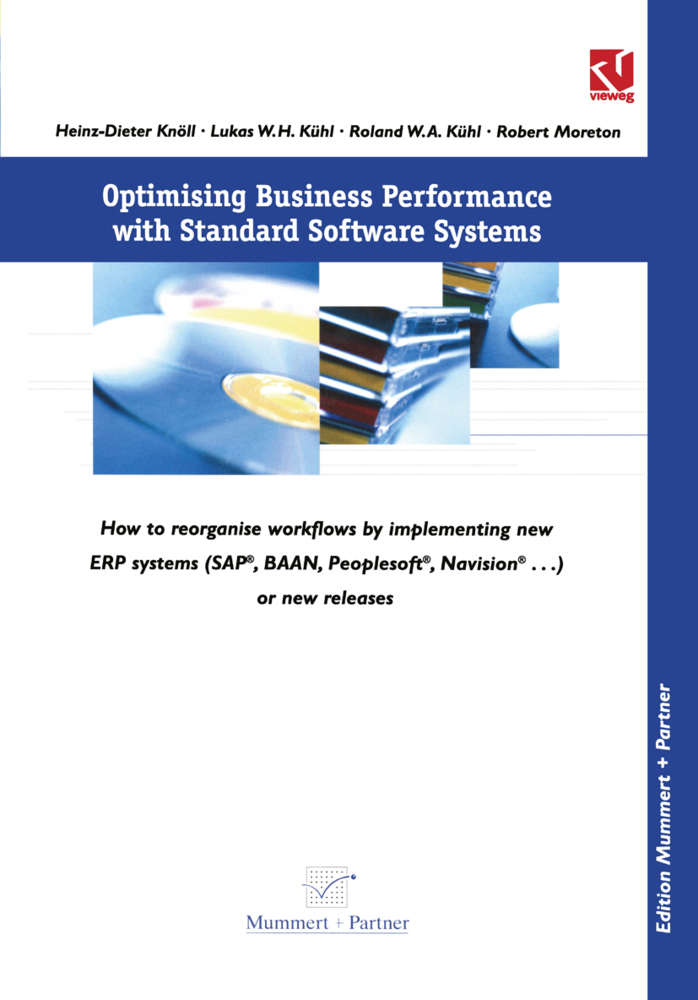Dekorationsartikel gehören nicht zum Leistungsumfang.
Sprache:
Englisch
106,99 €*
Versandkostenfrei per Post / DHL
Aktuell nicht verfügbar
Kategorien:
Beschreibung
Preface In recent years Standard Software has evolved from a tool for supporting commercial/administrative activities (e.g. financial ac counting) to integrated systems that cover entire business proc esses in companies. The rapid development of these systems, an increasing number of implementations, and the suppliers' an nouncements concerning the functional extension of their sys tems lead us to expect a further market penetration of Standard Software. SAP's Industrial Solutions, for instance, which are of fered for the key processes of entire lines of business demon strate the impressive success of Standard Software Systems. The widespread implementation of commercial Standard Soft ware has reqUired considerable investments by industrial and service companies. Now it is time to verify if the planned gains and advantages of these systems have actually been realised, i.e. one has to ask whether the systems payoff as originally ex pected. It has to be kept in mind that the vendors have promised far-reaching optimisation of their clients' business processes by means of the so called best-practice reference processes implied by their systems. The advantages of these best-practices should have been incorporated in the processes of the respective com panies. On closer inspection, one can see that the claimed advantages of the systems' capabilities in terms of optimised processes have not been realised in many of the current implementations. Studies and interviews undertaken with applying companies as part of the research for this book confirm this finding.
Preface In recent years Standard Software has evolved from a tool for supporting commercial/administrative activities (e.g. financial ac counting) to integrated systems that cover entire business proc esses in companies. The rapid development of these systems, an increasing number of implementations, and the suppliers' an nouncements concerning the functional extension of their sys tems lead us to expect a further market penetration of Standard Software. SAP's Industrial Solutions, for instance, which are of fered for the key processes of entire lines of business demon strate the impressive success of Standard Software Systems. The widespread implementation of commercial Standard Soft ware has reqUired considerable investments by industrial and service companies. Now it is time to verify if the planned gains and advantages of these systems have actually been realised, i.e. one has to ask whether the systems payoff as originally ex pected. It has to be kept in mind that the vendors have promised far-reaching optimisation of their clients' business processes by means of the so called best-practice reference processes implied by their systems. The advantages of these best-practices should have been incorporated in the processes of the respective com panies. On closer inspection, one can see that the claimed advantages of the systems' capabilities in terms of optimised processes have not been realised in many of the current implementations. Studies and interviews undertaken with applying companies as part of the research for this book confirm this finding.
Inhaltsverzeichnis
1 Preliminary Overview.- 1.1 Purpose of the Book.- 1.2 Structure of the Book.- 1.3 References and Pictograms.- 2 Standard Software: Hope and Disappointment.- 2.1 The Challenge: Why do Companies use Standard Software?.- 2.2 The missed Opportunity: Why does Standard Software often not meet a Company's Requirements?.- 2.3 Classification of Standard Software.- 2.4 The Creative Destruction: What are the Implications of an Updated Software Release?.- 2.5 Seize the Opportunity: Positive Benefits resulting from new Software Releases.- 3 The Evolution of Business Process Orientation: From Fiction to Reality.- 3.1 The Business Process Paradigm.- 3.2 Historical Background.- 3.3 Philosophy of the Business Process Paradigm.- 3.4 The application specific context.- 4 Reveal the Opportunities: General Techniques for Business Process Optimisation.- 4.1 General Notes on BPR.- 4.2 Why Business Process Reengineering may fail.- 4.3 The Role of Business Process Optimisation (BPO).- 4.4 Object-Oriented Strategies.- 4.5 Function-Oriented Strategies.- 4.6 Resource-Oriented Strategies.- 4.7 Benchmarking.- 4.8 Reference Model based optimisation.- 4.9 Simulation.- 4.10 Algorithmic Optimisation / Approximation.- 5 Unwanted but Necessary: Popular Approaches to Business Process Modelling (BPM).- 5.1 General Considerations of Modelling and Design.- 5.2 The Benefits of Business Process Models.- 5.3 Difficulties in Modelling Business Processes.- 5.4 Properties of Process Models.- 5.5 General Techniques for the Representation of Process Flows.- 5.6 The Architecture of Integrated Information Systems.- 5.7 The Dynamic Enterprise Modeler.- 6 Beyond the Common View: Consideration of Interdisciplinary Aspects.- 6.1 Human and Social Aspects.- 6.2 Cognitive Aspects.- 6.3 Legal Aspects.- 6.4 EconomicalAspects.- 7 Viewing the Status Quo: Review of Life-Cycle Approaches.- 7.1 Structures and Properties of Life Cycle Models.- 7.2 Life-Cycle Models for Software Development.- 7.3 Implementing Process-Orientation.- 7.4 Standard Software Implementation Approaches.- 8 A Pragmatic Approach to a Semi-Process Driven Standard Software Implementation.- 8.1 General Preliminary Considerations.- 8.2 Scope of the Semi-Process Oriented Approach.- 8.3 Brief Illustration of the Project Phases.- 8.4 The Recommended Project Organisation.- 8.5 Tailoring the Approach.- 8.6 Meta Model and Key Components.- 8.7 Tool Support.- 8.8 Project Information.- 8.9 Towards a Simple Model Repository.- 8.10 Complementary Documentation.- 8.11 Success Factors and Risks.- 8.12 Phase 1: Preliminary Conception.- 8.13 Phase 2: Detailed Conception.- 8.14 Phase 3: Realisation.- 8.15 Specifics of a Release Migration Project (2nd Chance).- 8.16 Summary.
Details
| Erscheinungsjahr: | 2012 |
|---|---|
| Genre: | Technik |
| Rubrik: | Naturwissenschaften & Technik |
| Medium: | Taschenbuch |
| Seiten: | 426 |
| Titelzusatz: | How to reorganise Workflows by Chance of Implementing new ERP-Systems (SAP®, BAANTM, Peoplesoft®, Navision® ...) or new Releases |
| Inhalt: |
xvi
426 S. 294 s/w Illustr. 426 p. 294 illus. |
| ISBN-13: | 9783322898937 |
| ISBN-10: | 3322898938 |
| Sprache: | Englisch |
| Herstellernummer: | 978-3-322-89893-7 |
| Autor: |
Knöll, Heinz-Dieter
Kühl, Lukas W. H. Kühl, Roland W. A. Moreton, Robert |
| Auflage: | Softcover reprint of the original 1st ed. 2001 |
| Hersteller: |
Vieweg+Teubner
Vieweg+Teubner Verlag |
| Abbildungen: | XVI, 426 p. 294 illus. |
| Maße: | 245 x 173 x 24 mm |
| Von/Mit: | Heinz-Dieter Knöll (u. a.) |
| Erscheinungsdatum: | 06.05.2012 |
| Gewicht: | 0,782 kg |
Inhaltsverzeichnis
1 Preliminary Overview.- 1.1 Purpose of the Book.- 1.2 Structure of the Book.- 1.3 References and Pictograms.- 2 Standard Software: Hope and Disappointment.- 2.1 The Challenge: Why do Companies use Standard Software?.- 2.2 The missed Opportunity: Why does Standard Software often not meet a Company's Requirements?.- 2.3 Classification of Standard Software.- 2.4 The Creative Destruction: What are the Implications of an Updated Software Release?.- 2.5 Seize the Opportunity: Positive Benefits resulting from new Software Releases.- 3 The Evolution of Business Process Orientation: From Fiction to Reality.- 3.1 The Business Process Paradigm.- 3.2 Historical Background.- 3.3 Philosophy of the Business Process Paradigm.- 3.4 The application specific context.- 4 Reveal the Opportunities: General Techniques for Business Process Optimisation.- 4.1 General Notes on BPR.- 4.2 Why Business Process Reengineering may fail.- 4.3 The Role of Business Process Optimisation (BPO).- 4.4 Object-Oriented Strategies.- 4.5 Function-Oriented Strategies.- 4.6 Resource-Oriented Strategies.- 4.7 Benchmarking.- 4.8 Reference Model based optimisation.- 4.9 Simulation.- 4.10 Algorithmic Optimisation / Approximation.- 5 Unwanted but Necessary: Popular Approaches to Business Process Modelling (BPM).- 5.1 General Considerations of Modelling and Design.- 5.2 The Benefits of Business Process Models.- 5.3 Difficulties in Modelling Business Processes.- 5.4 Properties of Process Models.- 5.5 General Techniques for the Representation of Process Flows.- 5.6 The Architecture of Integrated Information Systems.- 5.7 The Dynamic Enterprise Modeler.- 6 Beyond the Common View: Consideration of Interdisciplinary Aspects.- 6.1 Human and Social Aspects.- 6.2 Cognitive Aspects.- 6.3 Legal Aspects.- 6.4 EconomicalAspects.- 7 Viewing the Status Quo: Review of Life-Cycle Approaches.- 7.1 Structures and Properties of Life Cycle Models.- 7.2 Life-Cycle Models for Software Development.- 7.3 Implementing Process-Orientation.- 7.4 Standard Software Implementation Approaches.- 8 A Pragmatic Approach to a Semi-Process Driven Standard Software Implementation.- 8.1 General Preliminary Considerations.- 8.2 Scope of the Semi-Process Oriented Approach.- 8.3 Brief Illustration of the Project Phases.- 8.4 The Recommended Project Organisation.- 8.5 Tailoring the Approach.- 8.6 Meta Model and Key Components.- 8.7 Tool Support.- 8.8 Project Information.- 8.9 Towards a Simple Model Repository.- 8.10 Complementary Documentation.- 8.11 Success Factors and Risks.- 8.12 Phase 1: Preliminary Conception.- 8.13 Phase 2: Detailed Conception.- 8.14 Phase 3: Realisation.- 8.15 Specifics of a Release Migration Project (2nd Chance).- 8.16 Summary.
Details
| Erscheinungsjahr: | 2012 |
|---|---|
| Genre: | Technik |
| Rubrik: | Naturwissenschaften & Technik |
| Medium: | Taschenbuch |
| Seiten: | 426 |
| Titelzusatz: | How to reorganise Workflows by Chance of Implementing new ERP-Systems (SAP®, BAANTM, Peoplesoft®, Navision® ...) or new Releases |
| Inhalt: |
xvi
426 S. 294 s/w Illustr. 426 p. 294 illus. |
| ISBN-13: | 9783322898937 |
| ISBN-10: | 3322898938 |
| Sprache: | Englisch |
| Herstellernummer: | 978-3-322-89893-7 |
| Autor: |
Knöll, Heinz-Dieter
Kühl, Lukas W. H. Kühl, Roland W. A. Moreton, Robert |
| Auflage: | Softcover reprint of the original 1st ed. 2001 |
| Hersteller: |
Vieweg+Teubner
Vieweg+Teubner Verlag |
| Abbildungen: | XVI, 426 p. 294 illus. |
| Maße: | 245 x 173 x 24 mm |
| Von/Mit: | Heinz-Dieter Knöll (u. a.) |
| Erscheinungsdatum: | 06.05.2012 |
| Gewicht: | 0,782 kg |
Warnhinweis










